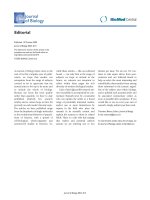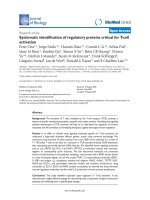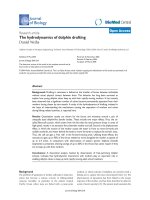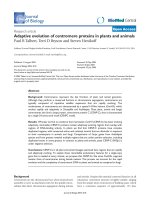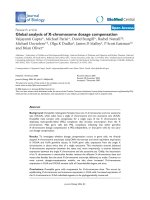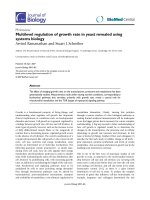Báo cáo sinh học: "Expected efficiency of selection for growth in a French beef cattle breeding scheme. II. Prediction of asymptotic genetic gain in a heterogeneous population" docx
Bạn đang xem bản rút gọn của tài liệu. Xem và tải ngay bản đầy đủ của tài liệu tại đây (881.46 KB, 18 trang )
Original
article
Expected
efficiency
of
selection
for
growth
in
a
French
beef
cattle
breeding
scheme.
II.
Prediction
of
asymptotic
genetic
gain
in
a
heterogeneous
population
F
Phocas
JJ
Colleau,
F
Ménissier
Institut
national
de
la
recherche
agronomique,
station
de
g6n6tique
quantitative
et
appliqu6e,
78352
Jouy-en-Josas
cedex,
France
(Received
24
February
1994;
accepted
18
October
1994)
Summary -
Asymptotic
genetic
gains
and
lags
are
derived
in
French
beef
cattle
breeding
schemes
for
an
objective
including
direct
and
maternal
effects
on
growth.
A
simple
general
method
using
matrix
algebra
is
presented
to
simultaneously
calculate
asymptotic
genetic
gains
and
lags,
whatever
the
population
structure.
The
heterogeneity
of
use
of
artificial
insemination
(AI)
in
selection
herds
is
considered.
At
the
same
overall
rate
of
AI
use,
larger
asymptotic
genetic
gains
can
be
obtained
by
concentrating
AI
in
only
a
fraction
of
the
herds
instead
of
keeping
the
same
lower
rate
in
all
herds.
An
application
concerns
the
Limousin
selection
nucleus,
where
23%
of calves
are
bred
by
AI
in
only
50%
of
the
herds.
When
an
aggregate
breeding
objective
for
growth
is
considered,
positive
annual
asymptotic
genetic
gains
are
expected
in
both
direct
(+
0.13
genetic
standard
deviation)
and
maternal
effects
(+ 0.05
genetic
standard
deviation)
on
growth,
despite
the
negative
estimates
(around
- 0.2)
of
genetic
direct-maternal
correlations.
The
major
part
of
the
genetic
gains
in
direct
and
maternal
effects
are
due
to
AI
sire
selection
and
dam
selection
respectively.
Taking
into
account
sampling
uncertainty
in
estimates
of
preweaning
genetic
parameters
leads
to
the
conclusion
that
the
predicted
asymptotic
response
in
maternal
effects
is
positive
with
a
very
high
probability.
Nevertheless,
strongly
negative
(around
-0.6)
estimates
of
correlations
between
direct
and
maternal
effects
lead
to
negative
responses
in
maternal
effects.
beef
cattle
/
growth
/
asymptotic
genetic
gain
/
open
nucleus
/
sampling
variance
Résumé -
Prédiction
de
l’efficacité
d’un
schéma
de
sélection
français
sur
la
croissance
en
race
bovine
allaitante.
II.
Prédiction
du
progrès
génétique
asymptotique
dans
une
population
hétérogène.
Dans
un
schéma
de
sélection
français
en
race
bovine
allaitante,
les
progrès
et
les
retards
génétiques
asymptotiques
sont
calculés
pour
un
objectif
de
sélection
incluant
effects
directs
et
maternels
sur
la
croissance.
Quelle
que
soit
la
structure
de
la
population
considérée,
une
formulation
matricielle
simple
permet
de
calculer
simultanément
ces
progrès
et
ces
retards
génétiques
asymptotiques.
Ainsi,
l’utilisation
différentielle
de
l’insémination
artificielle
(IA)
dans
les
troupeaux
de
sélection
est
aisément
prise
en
compte.
Pour
un
même
taux
d’IA
sur
l’ensemble
du
noyau
de
sélection,
des
progrès
génétiques
plus
importants
peuvent
être
obtenus
en
utilisant
l’IA
dans
une
partie
seulement
des
troupeaux,
plutôt
qu’en
considérant
une
plus
faible
utilisation
de
l’IA,
mais
identique
d’un
troupeau
à
un
autre. Les
paramètres
démographiques
et
génétiques
utilisés
correspondent
au
noyau
de
sélection
de
la
race
Limousine,
où
23%
des
veaux
sont
procréés
par
IA
dans
seulement
50%
des
troupeaux.
Pour
un
objectif
de
sélection
composite
concernant
les
caractères
de
croissance,
des
progrès
génétiques
annuels
positifs
sont
espérés
tant
pour
les
effets
directs
(+
0, 13
écart
type
génétique)
que
pour
les
effets
maternels
(+
0, 05
écart
type
génétique),
malgré
les
estimées
négatives
(autour
de -
0,
2)
des
corrélations
génétiques
entre
ces
effets.
Ces
progrès
génétiques
sont
essentiellement
dus
à
la
sélection
des
taureaux
d’IA
pour
les
effets
directs
et
à
la
sélection
des
mères
pour
les
effets
maternels.
La
prise
en
compte
d’une
incertitude
d’échantillonnage
sur
les
estimées
des
paramètres
génétiques
pré-sevrage
aboutit
à
la
conclusion
que
la
réponse
prédite
sur
les
effets
maternels
est
positive
avec
une
très
forte
probabilité.
Néanmoins,
des
estimées
très fortement
négatives
(autour
de
-0, 6)
des
corrélations
entre
effets
directs
et
maternels
induisent
des
réponses
négatives
sur
les
effets
maternels.
bovin
allaitant
/
croissance
/
progrès
génétique
asymptotique
/
noyau
ouvert
/
variance
d’échantillonnage
INTRODUCTION
Animal
breeding
schemes
are
usually
illustrated
by
a
pyramid
with
several
tiers.
For
instance,
beef
cattle
breeding
programs
account
for
2
main
tiers
in
the
pyramid:
a
selection
nucleus
at
the
apex
and
a
base
commercial
population,
with
a
downward
gene
flow.
In
French
beef
cattle
breeding
schemes,
the
nucleus
is
not
homogeneous
because
of
the
use
of
2
reproduction
methods,
artificial
insemination
(AI)
and
natural
service
(NS).
A
significant
proportion
of
herds
do
not
even
use
AI.
Thus,
the
nucleus
can
be
split
into
several
tiers
depending
on
the
magnitude
of
AI
use.
These
tiers
must
be
considered
as
open
subnuclei
since
there
are
gene
exchanges
between
them.
Moreover,
the
nucleus
is
said
to
be
heterogeneous,
since
newborn
calves,
candidates
for
selection,
can
be
classified
into
different
groups
for
each
sex,
according
to
their
genetic
level;
indeed,
a
higher
average
genetic
level
is
expected
for
calves
bred
.by
AI
than
for
calves
bred
by
NS.
The
aim
of
this
paper
is
to
predict
asymptotic
genetic
gains
in
growth
for
a
French
beef
cattle
breeding
scheme,
when
significant
heterogeneity
of
AI
use
is
observed
between
herds.
The
effect
on
this
prediction
of
sampling
uncertainty
in
estimates
of
preweaning
genetic
parameters
is
examined.
A
simple
matrix
method
is
presented
to
calculate
simultaneously
asymptotic
genetic
gains
and
lags
for
any
population
structure.
An
application
concerns
the
Limousin
breeding
scheme
where
the
selection
nucleus
can
be
divided
into
2
equal
tiers:
herds
with
a
constant
rate
of
AI
use
and
herds
without
AI
use.
The
prediction
of
the
genetic
gain
is
for
a
global
breeding
objective
Hg
for
growth
traits,
derived
in
a
previous
paper
(Phocas
et
al,
1995).
MATERIALS
AND METHODS
The
abbreviations
used
in
figures,
tables
and
text
are
listed
in
Appendix
I.
Modelling
of
the
breeding
scheme
Herd
structure
and
matings
With
600 000
cows,
the
Limousin
breed
is
the
second
French
beef
cattle
breed.
About
10%
of
these
cows
are
registered
and
recorded,
constituting
the
selection
nucleus
of
the
breed.
In
the
nucleus,
11.5%
of
the
cows
are
inseminated,
but
only
50%
of
the
herds
use
AI.
Thus,
the
nucleus
must
be
split
into
2
tiers:
a
tier
composed
of
the
50%
of
herds
with
a
rate
of
AI
equal
to
23%
and
another
tier
composed
of
the
50%
of
herds
without
AI
use.
A
hypothetical
one-tier
nucleus
where
AI
is
uniformly
used
in
all
herds
(11.5%)
was
also
modelled
in
order
to
evaluate
the
change
in
efficiency
related
to
the
heterogeneity
of
nucleus
herds.
Matings
were
assumed
to
be
independent
of
the
origin
of
the
parents
and
of
the
way
they
were
selected.
Selection
and
reproduction
of
females
were
completed
in
their
native
tier.
Bull
selection
Three
types
of
bulls
were
selected
among
the
19 000
males
recorded
at
weaning.
AI
bulls
AI
bull selection
was
described
in
a
previous
paper
(Phocas
et
al,
1995).
The
simplified
scheme
proposed
in
that
paper
was
considered
here.
AI
bulls
were
selected
for
a
first
use
at
5
years
of
age,
after
a
3-stage
selection
with
independent
culling
levels.
The
best
600
males
for
weaning
weight
(W210)
were
evaluated
in
performance
test
station
on
weight
at
400
d
(W400).
The
best
50
males
for
this
second
trait
were
then
evaluated
by
progeny
test
on
farm
according
to
an
optimum
index
(I
6)
combining
2
information
sources,
the
average
W210
of
30
sons
and
the
average
W120
of
20
daughters’
calves.
This
last
information
was
the
only
criterion
on
maternal
performance
considered
for
bull
selection.
Finally
20
males
were
selected
as
AI
bulls
for
both
nucleus
and
commercial
herds.
After
their
qualification
for
AI,
bulls
used
in
the
nucleus
were
selected
on
their
progeny
index
independently
of
their
age
and
origin,
with
a
selection
pressure
of
7%.
The
number
of
available
semen
doses
for
a
bull
was
assumed
to
be
constant
over
the
9
years
of
its
potential
utilization.
’
Station
NS
bulls
Two
hundred
males
were
selected
on
test
station
performance:
30
of
them
were
the
males
evaluated
by
progeny
test,
but
not
selected
for
AI
use;
the
other
170
were
the
best
males
on
W400
following
the
50
males
selected
for
a
progeny
test.
After
their
qualification
as
station
NS
bulls,
bulls
used
in
the
nucleus
were
selected
independently
of
their
age
and
origin,
with
a
selection
rate
of
80%.
Their
first
use
occurred
at
2
years
of
age
and
their
last
use
at
10
years.
Farm
NS
bulls
A
total
of
1 300
other
bulls
were
selected
for
NS
use:
380
were
those
evaluated
at
a
performance
test
station,
but
not
selected
as
AI
or
station
NS
bulls;
the
other
920
bulls
were
the
males
ranked
on
W210
immediately
after
the
best
600
were
selected
for
a
station
evaluation.
Their
first
use
occurred
at
1
year
old
and
their
last
use
at
a
maximum
of
9
years
old.
After
their
qualification
as
farm
NS
bulls,
bulls
were
chosen
at
random
each
year
of
their
use.
Cow
selection
A
total
of
50%
of
females
born
were
selected
for
replacement
within
tier
and
for
a
first
calving
at
2.5
years
old.
Selection
is
performed
on
an
optimum
index
(1
0)
combining
the
individual
W120
and
the
average
W120
of
10
paternal
half-sisters’
calves
(1
calf
recorded
per
half-sister).
After
this
first
selection
step,
cow
dams
were
chosen
at
random
until
a
last
calving
at
14
years
old.
Bull
dams
were
chosen
among
females
with
at
least
one
recorded
calf
and
with
a
selection
rate
of
63%.
Selection
was
performed
on
an
optimum
index
(I
d)
combining
the
average
W120
of
cows’
own
calves
and
the
2
criteria
used
for
heifer
selection.
This
index
depends
on
the
age
of
the
cow
(3-13
years),
since
it
was
assumed
that
each
year
an
additional
calf
is
recorded.
Description
of
cohorts
of
animals
Cohorts
at
birth
Let
n
be
the
number
of
cohorts
(Y)
of
newborn
animals.
In
our
applications, n
equals
4
or
6.
In
the
one-tier
nucleus,
Y
=
1
to
4
are
cohorts
of,
respectively,
males
bred
by
AI
(M1),
males
bred
by
NS
(M2),
females
bred
by
AI
(F1)
and
females
bred
by
NS
(F2).
In
the
two-tier
nucleus,
Y
=
1
to
6
are
cohorts
of,
respectively,
males
bred
by
AI
(M1),
males
bred
by
NS
in
the
tier
with
AI
use
(M2),
males
bred
by
NS
in
the
tier
without
AI
use
(M3),
females
bred
by
AI
(F1),
females
bred
by
NS
in
the
tier
with
AI
use
(F2)
and
females
bred
by
NS
in
the
other
tier
(F3).
Cohorts
of
candidates
for
selection
The
animals
were
grouped
into
cohorts
defined
by
sex,
age,
origin
(native
tier
and
reproduction
method),
mode
of
mating
(AI
or
NS)
and
mode
of
selection
(farm
or
station).
Table
I
presents
the
connection
between
origins
of
parental
cohorts
and
cohorts
at
birth.
Derivation
of
annual
genetic
gain
and
genetic
lags
The
asymptotic
genetic
gain
in
open
populations
is
usually
derived
by
calculating
the
year-by-year
change
of
genetic
values
until
the
steady
state
is
reached.
Con-
vergence
can
be
accelerated
by
using
deterministic
prediction
such
as
the
Rendel
and
Robertson
(1950)
formula.
However
this
formula
is
only
valid
for
closed
and
homogeneous
populations.
In
beef
cattle
breeding
schemes,
sires
(or
dams)
are
se-
lected
within
an
age
class
among
several
groups
of
different
average
genetic
merits
at
birth,
such
as
a
group
of
animals
bred
by
AI
and
a
group
of
animals
bred
by
NS.
Therefore,
the
unimodal
assumption
of
candidates
for
selection
within
an
age
class
is
not
valid.
Moreover,
the
probabilities
of
origin
of
each
kind
of
breeding
animals
(for
instance,
AI
and
NS
bulls)
are
not
the
same.
In
such
heterogeneous
popula-
tions,
a
’gene
flow’
analysis
is
needed
to
find
the
weightings
of
the
different
selection
differentials
in
order
to
calculate
the
asymptotic
genetic
gain.
These
weightings
are
generally
derived
for
special
situations.
James
(1977)
gave
an
analytical
expression
for
the
steady-state
genetic
gain
in
an
open
nucleus,
ie
a
2-tier
population
structure,
with
discrete
generations.
Shepherd
and
Kinghorn
(1992)
derived
an
analytical
ex-
pression
in
a
3-tier
population
structure.
Elsen
(1993)
gave
general
matrix
formulae
to
compute
successively
asymptotic
genetic
gain
and
genetic
lags
for
any
population
structure.
Here,
we
propose
a
simpler
and
more
direct
matrix
formulation
which
provides
these
parameters
simultaneously
for
any
population
structure
and
without
any
calculation
of
eigenvectors.
The
previous
methods
use
known
selection
differentials,
generation
intervals
and
proportions
of
the
different
kinds
of
parents
per
cohort
of
offspring.
However
these
parameters
depend
on
genetic
lags
between
all
cohorts
of
candidates
to
selection.
Therefore,
a
recursive
2-step
algorithm
is
used
to
calculate
asymptotic
genetic
evolution:
(i)
derivation
of
selection
differentials,
generation
intervals
and
proportions
of
parents
used
by
the
Ducrocq
and
Quaas
(1988)
method;
(ii)
knowing
the
parameters
in
(i),
derivation
of
asymptotic
genetic
gains
and
lags
by
our
matrix
method;
and
(iii)
iterative
calculations
of
(i)
and
(ii)
until
convergence
is
reached
(about
6
iterations
instead
of
40
for
a
year-by-year
algorithm).
The
first
step
of
this
algorithm
makes
use
of
the
asymptotic
results
derived
in
the
second
step.
Thus,
between
2
cohorts
of
animals
of
the
same
origin
but
of
different
ages
(i
and
j)
the
genetic
lag
at
birth
is:
(j -
i)OG.
The
genetic
lags
at
birth
between
cohorts
of
candidates
for
selection
with
different
origins
are
also
used
recursively
to
derive
selection
differentials.
Ducrocq
and
Quaas
(1988)
have
previously
used such
a
2-step
algorithm
to
derive
genetic
gain
by
the
Rendel
and
Robertson
(1950)
formula
in
a
closed
homogeneous
population
with
overlapping
generations.
First
step
of
the
algorithm:
derivation
of
selection
differentials,
genera-
tion
intervals
and
proportions
of
each
kind
of
parent
used
to
produce
a
given
offspring
’
Selection
differentials
are
calculated
for
all
the
variables
considered
in
the
selection
objective
and
criteria
(A120,
M120,
A210,
M210,
A400
and
A500),
in
order
to
rebuild
a
means
of
selection
indices
for
all
cohorts
of
candidates
for
selection
for
the
next
iteration.
In
order
to
simplify
notations,
the
subscripts
indicating
the
variable
considered
are
dropped
in
the
following
equations.
Animals,
from
age
(i)
and
origin
(X )
classes,
are
selected
in
W
(farm
or
station)
to
produce
offspring
Y,
by
using
the
same
truncation
point
across
classes.
This
maximizes
the
average
selection
differential
S
xYw
and
simultaneously
optimizes
the
generation
interval
and
the
proportions
of
the
different
kinds
(X)
of
parents
used
to
produce
a
given
kind
(Y)
of
offspring.
Animals
are
assumed
to
be
unrelated
and
within
a
class
to
have
an
equal
amount
of
information.
Ducrocq
and
Quaas
(1988)
described
the
algorithm
to
calculate
the
relevant
truncation
point,
given
the
number
of
animals
to
be
selected
and
the
number
of
candidates
in
each
age
class
(table
II).
where
pxyw(i)
is
the
proportion
of
animals
selected
in
W
from
cohort X
of
age
i to
produce
the
offspring
Y
f
xY
(i)
is
the
fraction
of
candidates
for
selection
to
produce
offspring
Y,
belonging
to
the
cohort X
of
age
i compared
to
all
cohorts
<
X,
i
>
Px
Yw
is
the
total
proportion
of
animals
selected
in
W
from
cohorts
<
X,
i >
to
produce
the
offspring
Y:
Pxyw
=
! fxY(i)2!xYw(i).
Generation
intervals
are
i
easily
derived
as:
Lxyw
= E a
x
yw(i)i.
.
i
The
method
described
by
Tallis
(1961)
is
used
to
derive
within-cohort
selection
differentials
sx
Y
w (i)
after
a
multistage
selection,
assuming
a
multivariate
normal
distribution
of
traits
and
treating
candidates
for
selection
as
independent
observa-
tions.
As
proposed
by
Ducrocq
and
Colleau
(1986),
numerical
integration
is
carried
out
by
Dutt’s
method.
A
2-step
selection
is
considered
for
bull
dams
and
station
NS
bulls
and
a
3-step
selection
for
AI
bulls.
Only
cow
dams
and
farm
NS
bulls
are
selected
in
one
step.
Second
step
of
the
algorithm:
derivation
of
asymptotic
annual
genetic
gains
and
lags
An
arbitrary
reference
cohort
of
mean
genetic
level
Ml
is
used
to
define
(n -
1)
independent
genetic
lags
Cy
as:
Cy
=
MY
-
Ml
for
Y
=
2
to
n.
is
the
transition
matrix
between
breeding
values
at
birth
of
parents
X
and
progeny
Y.
Each
element
t
ij
represents
the
average
fraction
of
genotype
of
progeny
i
which
is
identical
to
genotype
of
parent j;
thus,
the
t
ij
s
are
probabilities
of
gene
transmission.
T
is
partitioned
into
4
sub-matrices:
t
ll
is
a
scalar,
T
12
is
a
row
vector
with
elements
t
lk
,
T
21
is
a
column
vector
with
elements
t!l
for
k
=
2
n,
and
T
22
is
a
matrix
of
(ri, -
1)
x
(n -
1)
size.
is
the
vector
of
the
average
generation
intervals
after
weighting
by
the
above
probabilities
of
gene
transmission;
ui
is
the
average
generation
interval
for
progeny
cohort
1,
U2
is
the
vector
of
the
(n —
1)
other
progeny
cohorts.
is
the
vector
of
the
corresponding
average
selection
differentials.
The
asymptotic
result
is
then:
The
first
step
of
the
demonstration
is
to
derive
mean
genetic
values
My
of
all
cohorts
Y
at
birth,
by
considering
the
average
genetic
values
of
parental
cohorts
X:
where:
Ax(i)
is
the
mean
genetic
level
at
birth
of
parental
cohort
X,
i years
before
the
birth
of
their
offspring
Y.
As
the
mean
genetic
level
of
each
cohort
at
birth
is
assumed
to
increase
asymptotically
with
a
constant
rate
per
year
AG,
AX (i)
can
be
expressed
as:
wxyw(i)
is
the
proportion
of
parents
selected
in
W
from
cohort
of
age
i,
among
the
parents
X
of
offspring
Y,
bxy
is
the
intra-sex
proportion
of
parents
of
type
X
used
to
produce
offspring
Y.
Thus,
where
m
is
the
number
of
male
cohorts
and n -
m
the
number
of
female
cohorts.
Provided
that
the
asymptotic
state
is
reached
and
pooling
equations
[1]
and
(2!,
the
following
equation
is
obtained:
X
=
1
to
m
corresponds
to
the
different
cohorts
of
sires;
X =
m+1
to n
corresponds
to
the
cohorts
of
dams.
Aiy
and
6
iT
are
the
average
generation
interval
and
the
average
selection
differential
respectively
of
selected
animals
of
sex
i to
produce
offspring
Y.
By
defining
the
following
system
can
be
written
in
matrix
notation:
Equation
[3]
can
be
rewritten
with
the
mean
genetic
level
of
all
cohorts
Y
(at
any
time)
expressed
in
reference
to
the
cohort Y
=
1
at
time
t:
Cy
=
MY
-
Ml.
Thus,
at
time
t:
At
time
t +
1,
the
improvement
rate
is
AG
for
each
cohort
and,
thus,
the
first
line
of
the
previous
system
becomes:
Hence,
where q
i
is
the
ith
term
of
the
row
vector
t
ll
Ti2
].
Because
pooling
equation
[5]
with
the n —
1
last
rows
of
equation
[4]
gives:
Appendix
II
shows
the
equivalence
of
this
results
with
the
Rendel
and
Robertson
(1950)
formula
in
a
closed
homogeneous
population.
Uncertainty
in
predicting
genetic
gain
and
lags
.
The
genetic
parameters
used
in
the
present
study
for
direct
and
maternal
effects
at
120
and
210
d
were
estimated
by
Shi
et
al
(1993)
in
the
Limousin
breed.
The
other
genetic
parameters
were
taken
from
the
review
by
Renand
et
al
(1992).
These
parameters
are
presented
in
our
previous
paper
(Phocas
et
al,
1995).
Accuracies
of
selection
indices
to
predict
Hg
are
presented
in
table
III.
The
procedure
proposed
by
Foulley
and
Ollivier
(1986)
was
used
to
test
whether
phenotypic
and
genetic
covariance
matrices
were
coherent.
As
stressed
by
Meyer
(1992),
sampling
covariances
of
estimates
of
variance
components
including
maternal
effects
are
very
high,
even
for
designs
specifically
dedicated
to
the
estimation
of
maternal
effects.
However,
in
most
cases,
sampling
covariances
of
such
estimates
are
not
calculated
because
of
high
computing
costs.
Thus,
a
theoretical
structure
of
data
was
constructed
to
evaluate
sampling
variances
and
covariances
between
preweaning
genetic
parameters
(Phocas
et
al,
1995).
The
sampling
variance-covariance
matrix
is
derived
for
4050
observations
originated
from
90
unrelated
sires
and
90
unrelated
maternal
grandsires
with
45
bulls
used
as
sires
of
90
calves
and
as
maternal
grandsires
of
90
other
calves.
The
calculated
uncertainty
in
direct
variances
corresponds
to
values
frequently
found
in
the
literature
(coefficient
of
variation
around
20%).
In
order
to
take
into
account
such
an
uncertainty
in
preweaning
genetic
parame-
ters
(vector
6),
variances
of
asymptotic
predicted
genetic
gain
and
genetic
lags
are
derived
using
the
first-order
term
of
a
Taylor
expansion
with
derivatives
calculated
by
finite
differences:
RESULTS
AND
DISCUSSION
Asymptotic
genetic
gains
In
this
study,
we
have
focused
on
asymptotic
genetic
gain
(table
IV)
in
order
to
discriminate
among
different
breeding
plans
since
this
criterion
is
not
influenced
by
the
initial
state
of
the
population.
Therefore,
we
ignore
commercial
herds
since
there
are
no
genes
returned
to
the
nucleus
and
thus,
asymptotically
the
overall
population
progresses
genetically
at
the
same
rate
as
the
nucleus
(Bichard,
1971;
Elsen,
1980).
Expected
values
Concentrating
AI
in
half
of
the
selection
nucleus
leads
to
higher
expected
genetic
gains
(+
8%
in
Hg
and
A210,
+
10%
in
A500
and
+
6%
in
M210)
than
using
AI
all
over
the
selection
nucleus.
The
tier
defined
by
herds
using
AI
must
be
considered
as
the
elite
subnucleus;
the
major
part
of
genetic
improvement
is
created
in
that
tier.
The
expected
asymptotic
genetic
gain
in
final
weight
lies
above
the
value
(8%
of
a
genetic
standard
deviation)
calculated
by
Colleau
and
Elsen
(1988).
These
authors
assumed
no
dam-to-daughter
selection
and
excluded
from
the
selection
nucleus
animals
bred
by
NS.
Expected
asymptotic
genetic
gain
in
direct
effects
on
weaning
weight
is
4
times
as
large
as
the
observed
gain,
estimated
by
the
best
linear
unbiased
prediction
(BLUP)
animal
model
method
over
the
period
from
1972
to
1994
(unpublished
results).
The
expected
asymptotic
gain
in
M210
is
small
but
real,
whereas
the
observed
gain
is
estimated
to
be
nil.
The
importance
of
the
difference
between
observed
and
expected
genetic
gains
is
probably
mainly
related
to
losses
of
efficiency
in
the
implementation
of
the
modelled
breeding
scheme.
Other
causes
can
also
explain
a
part
of
the
difference;
the
steady-state
equilibrium
is
probably
not
reached
since
the
current
breeding
scheme
has
been
only
implemented
since
1980.
Reduction
of
genetic
variance
due
to
selection,
inbreeding
and
increased
relationships
between
animals
are
not
considered
in
our
study.
In
order
to
evaluate
the
importance
of
the
selection
of
each
kind
of
breeding
animals,
some
selection
paths
were
suppressed
to
derive
genetic
gains
in
the
2-tier
nucleus.
The
main
part
of
genetic
improvement
is
due
to
the
selection
of
AI
and
station
NS
bulls;
it
accounts
for
45%
of
the
genetic
improvement
in
Hg
and
for
15%
in
M210,
whereas
these
bulls
are
sires
of
only
23%
of
the
calves
born.
Farm
NS
bulls
are
sires
of
77%
of
the
calves
born,
but
account
for
only
15%
of
the
genetic
gains
in
Hg
and
M210.
Dam
selection
accounts
for
about
30%
of
the
genetic
gains
in
Hg
and
M210.
Dam
selection
accounts
for
about
30%
of
the
genetic
gains
in
Hg
and
75%
in
M210.
Consequently,
genetic
improvement
in
maternal
effects
is
mainly
due
to
cow
selection
on
farm.
Uncertainty
due
to
the
estimation
of
preweaning
parameters
The
uncertainty
in
genetic
gains
is
independent
of
the
structure
of
the
nucleus
(table
IV).
The
coefficients
of
variation
of
direct
and
global
responses
are
around
10%;
the
coefficient
of
variation
of
maternal
response
is
nearly
50%.
Predicted
genetic
responses
seem
to
be
robust
to
values
of
genetic
parameters
since
coefficients
of
variation
for
predicted
genetic
responses
are
smaller
than
those
of
estimated
genetic
parameters,
at
least
as
far
as
direct
and
global
responses
are
considered.
The
uncertainty
in
maternal
genetic
response
is
intermediate
between
uncertainty
in
maternal
(co)variances
(33%)
and
uncertainty
in
direct-maternal
covariances
(100%).
Such
a
result
is
in
contrast
to
the
results
of
Sales
and
Hill
(1976a,
b)
on
the
variance
of
predicted
responses
due
to
index
selection.
However
here
we
consider
a
complex
breeding
scheme
with
multistage
selection
and
use
of
different
indices
according
to
the
stage
of
selection
and
the
kind
of
breeding
animal
considered.
Sampling
correlations
between
responses
are
highly
positive:
0.9
between
global
and
direct
genetic
gain;
0.8
between
global
and
maternal
responses;
0.99
between
direct
responses
for
A210
and
A500;
0.7
between
responses
for
A500
and
M210;
and
0.6
between
responses
for
A210
and
M210.
Hence,
overestimation
(or
under-
estimation)
on
direct
responses
is
correlated
to
overestimation
(or
underestimation)
on
maternal
genetic
gain.
This
is
related
to
small
(0.07)
but
positive
sampling
correlations
between
direct
and
maternal
variances.
Moreover,
selection
is
mainly
performed
on
optimum
indices
combining
direct
and
maternal
performance.
Both
direct
and
maternal
responses
should
be
as
large
as
possible
to
maximize
the
response
on
the
breeding
objective.
Positive
responses
in
M210
may
be
considered
as
significant
if
genetic
gains
are
assumed
to
be
normally
distributed.
Estimated
values
of
genetic
correlations
between
direct
and
maternal
effects
are
in
the
average
range
of
values
seen
in
the
literature
(around
-0.2;
Shi,
1993).
Nevertheless,
much
more
negative
values
are
sometimes
estimated
or
suspected
in
extensive
production
systems.
If
values
of
genetic
correlations
between
direct
and
maternal
effects
were
assumed
equal
to
- 0.6,
a
negative
response
occurred
in
M210
(-2.5%
a
M2i
o)
and
losses
of efliciency
were
10
and
18%
in
direct
effects
and
in
the
breeding
objective
respectively.
Thus,
responses
are
very
dependent
on
the
values
of
direct-maternal
covariances,
when
these
are
the
worst
estimated
parameters.
Genetic
lags
Genetic
lags
(table
V)
between
sexes
are
shorter
than
6
months
since
selection
of
bulls
was
assumed
to
be
independent
of
the
sex
of
progeny.
Uncertainty
in
these
lags
is
important.
Genetic
lags
between
origins
are
larger,
but
with
a
smaller
relative
uncertainty.
Concentrating
AI
use
(2-tier
nucleus)
increases
genetic
lags
between
populations
bred
by
AI
and
NS.
Between
tiers,
the
genetic
lag
for
males
bred
by
NS
is
around
2
years.
Within
the
elite
tier,
the
genetic
lag
between
calves
bred
by
AI
and
NS
is
around
6
years.
This
underlines
the
necessity
of
classifying
animals
into
cohorts
according
to
the
reproduction
method
in
order
to
derive
proper
genetic
gains.
Origin
of
parents
of
each
cohort
of
calves
The
optimal
proportions
(according
to
origin)
of
the
parents
for
each
cohort
of
calves
are
derived
in
order
to
maximize
genetic
gain
in
the
breeding
objective
(table
VI).
Males
are
selected
to
produce
offspring
in
both
tiers,
independently
of
their
origin
(reproduction
method
and
native
tier);
females
are
selected
to
produce
offspring
in
their
native
tier,
but
independently
of
their
reproduction
method.
Uncertainties
in
these
optimal
proportions
are
quite
small.
Origin
of
dams
The
optimum
proportion
of
cow
dams
bred
by
AI
is
18%
in
the
one-tier
nucleus
and
35%
in
the
elite
tier
of
the
2-tier
nucleus.
The
proportion
of
bull
dams
bred
by
AI
is
bigger,
20%
in
the
one-tier
nucleus
and
42%
in
the
elite
tier
of
the
2-tier
nucleus,
due
to
a
more
intense
selection.
Whatever
the
structure
of
the
nucleus,
around
20%
of
all
dams
are
bred
by
AI
in
the
asymptotic
optimal
situation,
whereas,
in
reality,
only
10%
of
the
dams
are
bred
by
AI.
Origin
of
AI
sires
In
a
one-tier
nucleus,
91%
of
AI
bulls
are
themselves
bred
by
AI.
In
a
2-tier
nucleus,
this
proportion
is
even
larger
(97%)
due
to
a
small
increase
of
the
lag
between
males
bred
by
AI
and
males
bred
by
NS.
The
other
AI
bulls
are
bred
by
NS
in
herds
with
AI
use.
Thus
100%
of
AI
bulls
are
born
in
the
elite
tier,
ie
in
herds
with
AI
use.
This
optimal
strategy
is
far
from
reality;
currently
around
40%
of
AI
bulls
are
bred
by AI.
Origin
of
NS
sires
Whatever
the
structure
of
the
nucleus,
there
is
a
greater
proportion
of
sires
bred
by
AI
among
station
NS
bulls
(13.3%
of
NS
bulls)
than
among
farm
NS
bulls.
In
the
2-tier
nucleus,
63.5%
of
NS
bulls
are
born
in
the
elite
tier.
The
optimal
proportions
of
NS
bulls
bred
by
AI
are
20
and
23%
in
a
one-tier
and
2-tier
nuclei
respectively,
whereas
the
current
proportion
is
around
10%.
Generation
intervals
and
selection
differentials
Whatever
the
structure
of
the
nucleus,
optimal
generation
intervals
are
similar
(table
VII).
Optimal
values
of
generation
intervals
are
also
quite
independent
of
the
uncertainty
in
genetic
parameters;
the
coefficients
of
variation
are
smaller
than
2%.
Except
for
the
average
AI
sires
path,
taking
into
account
2
tiers
leads
to
smaller
average
selection
differentials;
-30%
on
the
cow
dams
path
and -10%
on
the
bull
dams
and
NS
sires
paths.
Since
animals
born
in
the
elite
tier
(herds
with
AI
use)
have
a
higher
average
genetic
level
than
animals
born
in
the
second
tier,
a
greater
proportion
of
males
is
selected
in
the
elite
tier
and
thus,
selection
differential
is
reduced.
The
AI
sires’
average
selection
differential
is
nearly
unchanged
since
the
large
proportion
of
AI
bulls
is
selected
from
males
bred
by
AI,
whose
number
is
the
same
in
both
cases.
These
results
are
in
apparent
contradiction
with
the
fact
that
genetic
gains
are
bigger
in
the
2-tier
nucleus
than
in
the
one-tier
one.
Using
the
Rendel
and
Robertson
(1950)
formula,
annual
genetic
gain
in
Hg
would
have
been
overestimated
whatever
the
structure
of
the
nucleus.
Moreover,
a
smaller
value
would
have
been
derived
in
the
2-tier
nucleus
(15.6%
of
genetic
standard
deviation)
than
in
the
one-tier
one
(16.9%
of
genetic
standard
deviation).
However
genetic
gain
cannot
be
calculated
as
a
simple
sum
on
each
selection
path,
weighted
by
the
proportion
of
calves
born
from
the
associated
kind
of
parents.
It
depends
on
the
gene
flow
between
and
within
tiers
and
between
the
animals
bred
by
AI
and
by
NS.
Concerning
the
uncertainty,
the
coefficients
of
variation
of
selection
differentials
are
similar
whatever
the
nucleus
structure.
They
are
much
larger
on
dam-selection
paths
than
on
sire-selection
paths.
This
must
be
related
to
the
fact
that
dam
selection
is
more
dependent
on
direct-maternal
covariances,
which
are
the
less
accurate
estimates.
Uncertainty
in
genetic
gain
in
Hg
is
in
the
range
of
uncertainty
about
AI
sires’
selection
differential.
This
underlines
the
importance
of
an
accurate
selection
of
AI
sires.
CONCLUSION
French
beef
cattle
breeding
schemes,
such
as
that
currently
in
place
for
the
Limousin
breed,
can
provide
significant
annual
genetic
gain
for
objectives
concerning
direct
and
maternal
effects
on
growth,
even
if
genetic
parameters
are
not
very
well
known.
However
a
full
evaluation
of
the
efficiency
of
such
selection
schemes
depends
on
the
inclusion
in
the
model
of
other
beef
traits
( eg,
feed
efficiency
and
carcass
quality)
and
maternal
performance
(eg,
fertility
and
ease
of
calving).
Beef
cattle
breeding
schemes
can
be
efficient
despite
a
small
number
of
inseminations
concentrated
in
only
a
part
of
a
herd.
Our
study
ignores
the
problem
of
correcting
performance
for
systematic
environmental
effects.
Their
estimation
requires
genetic
connections
between
herds,
which
would
be
more
difficult
to
set
up
when
AI
is
not
used
in
all
herds.
When
this
difficulty
is
overcome,
our
study
shows
that
it
can
be
advantageous,
at
a
constant
overall
rate
of
AI
in
the
selection
nucleus,
to
concentrate
AI
in
a
part
of
herds.
Consequently,
when
it
is
unrealistic
to
increase
AI
rate
in
all
herds,
one
way
to
improve
the
efficiency
of
the
breeding
scheme
may
be
to
maintain
a
basic
rate
of
AI
in
all
herds
to
ensure
genetic
connections
and
then
to
increase
AI
rate
in
only
a
part
of
the
herds.
REFERENCES
Bichard
M
(1971)
Dissemination
of
genetic
improvement
through
a
livestock
industry.
Anim
Prod
13,
401-411
Colleau
JJ,
Elsen
JM
(1988)
Potentialities
of
embryo
transfer
to
improvement
of
beef
cattle
and
sheep
productivity. 3’
Centres
Mondial
de
Reproduction
et
Sélection
des
Ovins
et
Bovins
a Viande.
Paris,
19-26
juin
1988.
INRA,
France,
vol
1,
141-157
Ducrocq
V,
Colleau
JJ
(1986)
Interest
in
quantitative
genetics
of
Dutt’s
and
Deak’s
methods
for
numerical
computation
of
multivariate
normal
probability
integrals.
Genet
Sel
Evol 18,
447-474
Ducrocq
V,
Quaas
RL
(1988)
Prediction
of
genetic
response
to
truncation
across
genera-
tions.
J
Dairy
Sci
71,
2543-2553
Elsen
JM
(1980)
Diffusion
du
progrès
g6n6tique
dans
les
populations
avec
generations
imbriqu6es :
quelques
propri6t6s
d’un
mod6le
de
prévision.
Ann
Genet
Sel
Anim
12,
49-80
Elsen
JM
(1993)
Prediction
of
annual
genetic
gain
and
improvement
lag
between
popula-
tions.
Genet
Sel
Evol
25,
75-82
Foulley
JL,
Ollivier
L
(1986)
A
note
on
criteria
of
coherence
for
the
parameters
used
to
construct
a
selection
index.
J
Anim
Breed
Genet
103,
81-86
James
JW
(1977)
Open
nucleus
breeding
systems.
Anim
Prod
24,
287-305
Meyer
K
(1992)
Bias
and
sampling
covariances
of
estimates
of
variance
components
due
to
maternal
effects.
Genet
Sel
Evol
24,
487-509
Phocas
F,
Colleau
JJ,
M6nissier
F
(1995)
Expected
efficiency
of
selection
for
growth
in
a
French
beef
cattle
breeding
scheme :
I.
Multistage
selection
of
bulls
used
in
artificial
insemination.
Genet
Sel
Evol 27,
149-170
Renand
G,
Plasse
D,
Andersen
BB
(1992)
Genetic
improvement
of
cattle
growth
and
carcass
traits.
In:
Beef
Cattle
Production.
(R
Jarrige,
C
Beranger,
ed),
Elsevier,
The
Netherlands,
86-107
Rendel
JM,
Robertson
A
(1950)
Estimation
of
genetic
gain
in
milk
yield
by
selection
in
a
close
herd
of
dairy
cattle.
J
Genet
50,
1-8
Sales
J,
Hill
WG
(1976a)
Effect
of
sampling
errors
on
efficiency
of
selection
indices.
I.
Use
of
information
from
relatives
for
single
trait
improvement.
Aninra
Prod
22,
1-17
Sales
J,
Hill
WG
(1976b)
Effect
of
sampling
errors
on
efficiency
of
selection
indices.
II.
Use
of
information
on
associated
traits
for
improvement
of
a
single
important
trait.
Anim
Prod
23,
1-14
Shepherd
RK,
Kinghorn
BP
(1992)
Optimising
multi-tier
open
nucleus
breeding
schemes.
Theor
Appl
Genet
85,
372-378
Shi
MJ,
Lalo6
D,
M6nissier
F,
Renand
G
(1993)
Estimation
of
genetic
parameters
of
preweaning
performance
in
the
French
Limousin
cattle
breed.
Genet
Sel
Evol
25,
177-189
Tallis
GM
(1961)
The
moment
generating
function
of
the
truncated
multi-normal
distri-
bution.
J R
Stat
Soc
323,
223-229
APPENDIX
I.
Meaning
of
the
abbreviations
used
Selection
indices
W120:
weight
at
120
d
W210:
weight
at
210
d
or
weaning
weight
W400:
weight
at
400
d
W500:
weight
at
500
d
or
final
weight
Ib:
index
on
bulls’
progeny
combining
the
average
W210
of
30
sons
with
the
average
W120
of
20
daughters’
calves
lo:
index
combining
the
own
W120
of
a
heifer
with
the
average
W120
of
the
first
calf
of
10
paternal
half-sisters
Im
15,
ho,
!d:
index
combining
the
own
W120
of
a
dam
with
the
average
W120
of
the
first
calf
of
10
paternal
half-sisters
and
with
the
W120
of
respectively
1,
5,
10
and
d
calves
of
the
dam
Breeding
values
A120:
direct
effects
on
W120
M120:
maternal
effects
on
W120
A210:
direct
effects
on
W210
M210:
maternal
effects
on
W210
A400:
direct
effects
on
W400
A500:
direct
effects
on
W500
Cohorts
at
birth
M1
(F1):
males
(females)
bred
by
Al
M2
(F2):
males
(females)
bred
by
NS
in
herds
with
AI
use
M3
(F3):
males
(females)
bred
by
NS
in
herds
without
AI
use
APPENDIX
II.
Deriving
Rendel
and
Robertson
formula
(1950)
from
our
general
matrix
equation
In
a
one-tier
homogeneous
nucleus,
only
2
birth
cohorts
must
be
considered:
males
(Y
=
1)
and
females
(Y
=
2).

